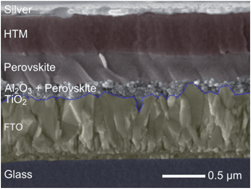
Although dye-sensitised solar cells (DSSCs) have been leading the charge in cheap-to-process cell designs, semiconducting perovskites have been used in recent years to replace the sensitiser in the DSSC architecture. Whilst this reduces the interfacial energy loss that plagues DSSCs, the metal oxide support layers still need to be sintered at 500°C, which is costly.
Continuing their work on a ‘meso-superstructured’ solar cell, where they simplified the design of semiconducting perovskite solar cells, EES Advisory Board member Henry Snaith and his group at the University of Oxford have used colloidal chemistry to deposit a support layer of aluminium(III) oxide. The highest temperature this method needs is a 150°C drying step, which will not only result in cheaper devices, but could also lead to better designs.
Although his device’s 12.3% efficiency is enough to rival the very best dye-sensitised solar cells, Snaith is still looking to improve efficiency, as well as stability, on his way to producing a commercial device. He is already predicting that his device will be much cheaper than existing silicon ones.
Read this HOT communication in Energy & Environmental Science today:
Low-temperature processed meso-superstructured to thin-film perovskite solar cells
James M. Ball, Michael M. Lee, Andrew Heya and Henry J. Snaith
DOI: 10.1039/C3EE40810H










